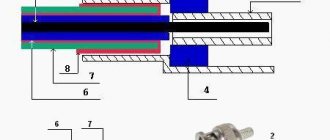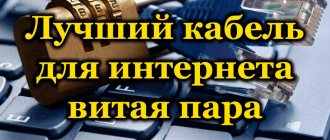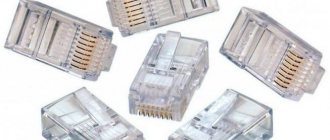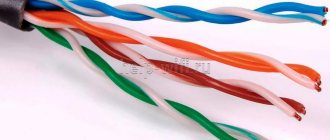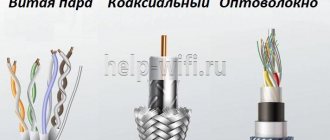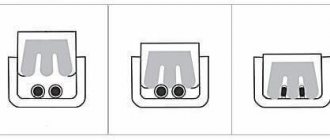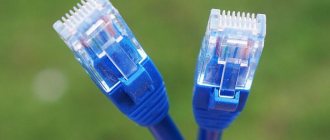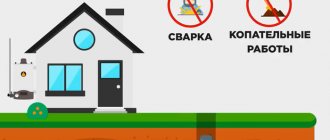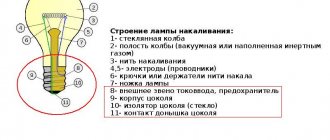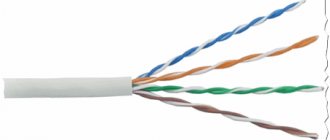First, let's figure out what a twisted pair cable is by definition? This is a structure of twisted copper wires in a single cable channel, and each substructure goes along a pair that is insulated. The braid is made of PVC material. In simpler terms, these are wires twisted first into a pair, and then a more complex base is twisted from these pairs.
Twisted pair cables are used to directly connect computers and laptops to switching equipment. With their help, networks are built, and data packets are transmitted through them. At the end of the twisted pair there is a so-called RJ45 or 8P8C connector.
This connection standard has several advantages:
- Cheap with a large connection area.
- Compatible with all network equipment.
- Large selection of classes: from internal use without shielding to more protected wires with braid.
HELP! If you have any questions while reading the article, then you can safely ask them in the comments at the very bottom. I can also help you choose the type and class of twisted pair cable for your premises.
Reasons for twisting
Why do they twist in pairs? First of all, this increases the reliability of the structure inside the primary braid. In this case, there will be no danger that the wires inside will fall apart, which can lead to damage during installation. Anyone who has ever laid a cable knows that this is important when pulling several cables into a small hole in the wall. If the pairs were not twisted inside, this would lead to more internal breaks. And it is very difficult to detect this after laying a long cable.
The second reason is to improve transmission quality. Electromagnetic and magnetic influences from the outside do not affect the entire cable area, but alternately due to twisting, thereby increasing the length of data transmission.
Information flows equally in pairs. And if there is interference along the way, the receiver receives both signals and simply subtracts the interference. That is, a second additional wire is needed to check the correctness of the transmitted signals.
This is how twisting works - when the first wire is located close to each other, it is exposed to maximum environmental impact. On the second paired wire, the impact is minimal, since it is hidden behind the first. And at the end the signals are added up.
NOTE! Inside, the wires are marked in pairs by color: orange, white-orange, green, white-green, blue, white-blue, brown, white-brown.
Now many people probably thought - after all, if you use all 8 wires to pass information, the speed will increase by 2 times. Yes, you are absolutly right. But here the question arises of reducing or complete protection from electromagnetic influence in order to reduce the chance of noise occurring during information transmission.
For this purpose there are high-quality wires with a shielding function. Then the electromagnetic influence will have almost no effect on the signal, there will be almost no noise and all 4 pairs of wires can be used. We will talk about braiding a little lower.
Example of Ethernet cable marking
When purchasing a cable, the marking is a guideline for all occasions. Let's look at an example of what it means and how to choose a twisted pair cable based on it.
What about installing fiber optics into your apartment?
The Blonde talked about what fiber optics is here.
The country's providers have already completely updated their network infrastructure, using fiber optics and related technologies to connect subscribers. This is beneficial for many reasons:
- High throughput.
- Kilometer cable length without signal loss.
- Saving space in optical line terminal cabinets (connecting thousands of subscribers from only one OLT).
Also, some providers, for example, Rostelecom, provide the service of installing fiber optics into the apartment. This is a great opportunity to get a high-quality high-speed signal.
But there is one nuance in which optical fiber can be brought into the apartment, and it is better to distribute it to rooms using twisted pair wire. Optical fiber is fragile and does not tolerate sharp bends. If this happens, the signal is lost and does not reach the final destination.
Therefore, to carry it into the apartment, a special fiber-optic cable is used for internal installation with super-flexible fiber and power elements (2), which, after passing through the wall cross-connect (3), is connected to an optical patch cord (4), which is connected to the media converter (1).
Conclusion
So, what wires are needed for the Internet? You need a single-core cable to be installed in an apartment for installation in walls, but to ensure connections between devices via a local network, it is recommended to use a multi-core cable. In general, if you will not make intricate bends in providing a local network, you can safely choose a wire marked Solid to deploy the entire network in the apartment. Shielding is not necessary. It is preferable to choose a pair, 5e category.
When laying local communication lines, an ethernet cable is used, which is available in several varieties (coaxial, fiber optic, twisted pair). The diameter of the cable, the composition and type of cores, the speed and quality of information transmission differ; products are produced solid and twisted, standard or shielded.
Characteristics, varieties, differences
Roughly speaking, there are two types:
- Internal VP - the outer braid is made of polyvinyl chloride, which is a cheap insulating material. There are, however, more expensive materials - polypropylene, polyethylene. The winding thickness does not exceed 0.3 mm.
- Outdoor VP - such wires have a thicker braid to protect the cores from moisture, dust, high and low temperatures. Additionally, there can be a screen of mesh and foiled base. The built-in plastic or metal cable prevents the wires from breaking when pulled. The thickness of the braid is 2-3 times thicker than that of the internal cable.
Inside, almost all models have a nylon thread, which protects the wire during installation from tension and tearing. But there is not thread everywhere on the internal cables. Street and more expensive office LAN wires have a shielded layer. It protects both from the influence of electromagnetic waves from the outside and does not release any waves into the environment. This is necessary when laying a large number of cables.
Based on external features they are distinguished:
- Gray – simple for office and home use.
- Black is thicker for the street.
- Orange – marked LSZH and made of non-flammable material. The installation is taking place in a fire hazardous area. In brackets is the fire safety category in the room where the cable is laid: ng( A) -HF – increased fire and explosion hazard;
- ng( B) -HF – moderate fire and explosion hazard;
- ng (C)-HF – fire hazardous;
- ng( D) -HF – reduced fire hazard.
By form:
- Round or oval are the most popular.
- Flat – for laying in walls under a flat base.
Number of cores:
- One core is also called monolithic. There is a copper wire line inside with a thickness of 0.2 to 0.6mm. This cord is very brittle and is usually laid in places with little bending.
- Multi-stranded – Multi-stranded wires have thin wires twisted inside them. Therefore, such cables are more resistant to magnetic influences. Also, in terms of signal attenuation range, they have a range from 85 to 95 meters. The flexion angle is higher.
Stranded wires are often used to connect digital and switching equipment: servers, PCs, printers, switches, routers, video surveillance cameras, etc.
Shielding is a reduction in the impact of electromagnetic influence on a cable, which reduces the loss of information packets and increases the transmission range without a repeater.
Let's look at this in more detail. Let's imagine that we have a twisted pair cable running from a computer to a router that is building a managed local network. Network devices constantly interact and transmit information: messages, pictures, videos, documents, etc. Each wire produces a small amount of electromagnetic radiation when sending a packet.
Now let's add here:
- Cell phones for employees or residents of the same apartment.
- Wi-Fi radiation from an access point.
- TV antenna.
- Radiofrequency exposure.
- Microwave.
Yes, in a small room such impacts will not have serious consequences. But if there are a lot of wires, and information needs to be transmitted over a long distance, then packets will be lost. As a result, the speed will drop, since the packet will have to be resent. Therefore, twisted pair cables are also divided according to the type of internal shielding.
Crimping diagram for a copper 4-wire network cable.
We have repeatedly mentioned in our articles the standard that regulates the rules for constructing wired LANs - EIA/TIA-568. Let us remember once again what is said there.
In modern networks, two methods of cable crimping are used - direct and crossover (synonyms - crossover, crossover). The segment connecting the computer to the network device (switch, router) is crimped in a direct way - the conductors at both ends of the segment are laid out in the same order. The segment connecting switch to switch or PC to PC is crimped using a crossover method - part of the conductors at the second end of the cable changes location. When cross-crimping a twisted pair of 4 cores, all conductors are swapped, as shown in the diagram.
Scheme for crimping a network cable of 4 cores
The wires of a four-core cable are usually colored green and orange (striped + solid), but there are others. It doesn’t matter what color to place first, the main thing is to maintain order. The diagram shows that the first, third, and sixth veins are involved here. Two of them are designed for receiving signals, the other two are for transmitting.
Crimping of a twisted pair of 4 cores can also be done on an eight-core cable, for example, to connect two computers to the router through one socket. To do this, the conductors are divided into two groups of two colors each, and then crimped according to one of the above schemes.
By the way, the text of EIA/TIA-568 does not say anything about how to crimp a twisted pair of 4 cores, that is, the method is not standardized. But it is still necessary to follow the approved rules, otherwise the patch cord will not work.
Shielding markings
- U (unshielded) – without shielding or protection.
- S (braided screening) – screening occurs only in the external structure. That is, under the main braid.
- F (foil) – foil shell shielding material.
- TP (twisted pair) is our favorite twisted pair.
- TQ - there is additional foil shielding for each pair of copper wires.
| Class | Description |
| UTP (U/UTP) | Unshielded twisted pair – no electromagnetic protection. |
| FTP (F/UTP) | Foiled twisted pair – the screen is located under the main braid. |
| STP (S/UTP) | Shielded twisted pair - under the first braid you can see one layer of mesh with a cross section, then for each pair of cores there is also a similar winding. |
| S/FTP (SF/UTP) | Screened Foiled twisted pair – two foil protective braids, for the base and pairs, as well as an external mesh. |
| U/FTP | Each wiring is shielded |
| SF/FTP | Mesh on the outside and foil protection for each pair. |
| U/STP | Unshielded Screened twisted pair - there is no external protection, but the pairs are braided |
| SF/UTP or SFTP | Screened Foiled Unshielded twisted pair - the first layer of shielding is made of mesh, and the second is made of foil. |
Ethernet to the rescue!
Naturally, if you have a wired network and very fast broadband Internet, you don't want to use a 100 Mbps (Fast Ethernet) connection between your computer and your ISP modem. That would be stupid! You need gigabit internet.
All you need is to connect all your home devices using inexpensive Cat 6 Ethernet cables, and use cheap Gigabit switches as the “nodes” to connect your devices.
My home network looks like this:
Pretty simple, isn't it?
The orange line is a Cat 6 Ethernet cable. You simply connect computers, routers, laptops using these cables and everything “just works”.
However, you should note that some laptops come with cheap built-in Fast Ethernet adapters that offer connection speeds of no more than 100 Mbps. If you have this situation with your computer, buy a gigabit USB-ethernet adapter.
Categories
Another way to call it is the class, which is marked with three letters CAT - this is a classification of twisted pair cables to indicate the approximate limit of signal pulse transmission speed and attenuation distance. With the history of twisted pair, the technology has constantly improved, and with it the frequency has also increased. Let's consider all twisted pairs.
CAT1
Has a channel frequency from 0.1 to 0.4 MHz. The most ancient, one might say antediluvian standard, which can only transmit voice from one cave to another. Once upon a time in the 90s, this was the only way to access the Internet using a modem.
- Speed : 256 Kbps.
- Frequency : 0.1 to 0.4 MHz.
CAT2
Previously used for telephone networks. Has two pairs. The maximum data transfer rate is 4 Mbit per second. Frequency from 1 to 4 MHz. Also an outdated standard, sometimes used to build Token Ring and Arcnet network flow. Once in demand for lining up old IBM 3270 terminal stations.
- Data transfer rate : 4 Mbit/s.
- Frequency : 1 million. up to 4 million Hz.
CAT3 (Class C)
Not a common format for building local networks (10BASE-T and token ring) and for transmitting data over short distances. Supports speeds from 10 to 100 Mbps. Maximum distance 100 meters. Supports packet data transmission standard – IEEE 802.3. Frequency 16 MHz.
- Bandwidth : 10 – 100 Mbit/s.
- Frequency : 16 MHz.
- Maximum distance : 0.1 km.
CAT4
One pair has a maximum speed of up to 16 Mbit per second. The frequency increases due to intense twisting. Number of pairs – 4. This standard is not used in Token Ring.
- Sending and receiving speed : 10 – 100 Mbit/s.
- Frequency : 20 million Hz
- Maximum distance : 0.1 km.
CAT5 (Class D)
A common format for constructing and transmitting digital information based on 10BASE-T, 100BASE-TX and 1000BASE-T networks. Now used to increase speed to Fast Ethernet and Gigabit Ethernet. You can use either two pairs or 4.
- Sending and receiving speed : 100 – 1000 Mbit/s.
- Frequency : 100 MHz
- Distance : 0.1 km.
CAT5e
Essentially this is the same network cable as CAT5, but its advantage is a thinner base. That is, the wiring is an order of magnitude smaller in diameter, which reduces the cost, but at the same time the characteristics are the same.
CAT6 (Class E)
Was officially added in 2002. It has only 4 pairs, but the transmission speed has increased to 10 Gbit per second. True, the distance decreased to 55 meters. Used to build networks using the 10GBASE-T standard over 10 Gigabit Ethernet. The cable is not shielded and is UTP class. Used to transmit large amounts of data over short distances. For example, for an interserver connection.
- Send and receive speed : 10 Gbit/s.
- Frequency : 250 MHz
- Signal attenuation length : 0.55 km.
CAT6a
The difference from the CAT6 class is the presence of a screen on the common braid (F/UTP) and on each pair (U/FTP). Due to this, the data transmission frequency rises to 500 MHz.
- Send and receive speed : 10 Gbit/s.
- Frequency : 500 MHz
- Signal attenuation length : 0.55 km.
CAT7 (Class F)
Still the same CAT6a, but the frequency has increased to 600 MHz due to the F/FTP or S/FTP braid. A little later, a modification was released according to the ISO 11801 standard, as a result of which the frequency increased to 1000 MHz.
- Send and receive speed : 10 Gbit/s.
- Frequency : 600 – 1000 MHz
- Distance : 0.55 km.
CAT8-8.1
The standard was created in the construction of 100 Gigabit Ethernet in the USA. The speed has increased to 40 Gbit per second. Screening as in 7th grade. The frequency increased to 1600 MHz, but later the technology was improved, and now it transmits data from 2000 MHz. Compatible with RJ45 connector standard. It has a 6A category cable with mesh braiding, foil on the outer sheath and double sheath for each pair.
- Speed : 40 Gbps.
- Frequency : 1600 – 2000 MHz
- Distance : 80 meters.
CAT8.2
This class is still in development and will be compatible with both GG45/ARJ45 and TERA connectors, as well as standard RJ45.
Twisted pair cable marking
The following markings are generally accepted, indicating the method of organizing shielding:
- UTP – cheap unshielded cable (may be designated U/UTP);
- FTP – a cable in which all pairs had a common shield (F/UTP);
- S-FTP – common double shield for all pairs with foil-coated aluminum core and tinned copper wire conductors (SF/UTP);
- STP – presence of a screen for each pair (U/FTP);
- F/FTP – separate screens for all pairs plus a common screen made of aluminum foil;
- S/FTP – separate screens for all pairs plus a common one made of tinned copper wire.
Types of cable shielding depending on marking
In general, a screen protects a cable from random and systematic interference that distorts the signal; it is necessary to prevent loss of information. Types of shielding indicate different levels of data protection. They largely determine the cost of the finished product.
Types of twisted pair
In addition to markings indicating the presence and method of organizing the screen, there are other designations used by manufacturers to indicate certain technical features of their products:
- Number of cores: solid – single-core cable, patch – multi-core. Monocores are cheap to produce, so they are the most common. Multicore products are used for complex network topologies in places of multiple bends. They are mainly used in the production of patch cords (a section of cable of a given length terminated with jacks for connecting devices).
- Core diameter. The range used is 0.40–0.64 mm. Cable products of categories 5–6 are made from conductors with a diameter of 51 mm and are designated 24AWG (American marking standard). A budget, often uncertified cable is made from 0.40–0.50 mm wire - for an apartment, the choice of such a twisted pair would be quite justified.
- Number of pairs When building complex communication systems, their number can reach thousands, but for computer networks the standard is 4 pairs (the marking accepted in the USA is 4x2x0.51). The use of all eight cores is required to build gigabit networks; for home use with a throughput of up to 100 Mb/s, two pairs are sufficient. And although such a cable is cheaper, usually in any case they purchase the eight-core version. Two pairs are used for arranging intercoms and alarm systems.
Twisted Pair Contents
We should also talk about marking by shell type:
- PVC – polyvinyl chloride sheath, used mainly for cheap cables;
- PP – polypropylene sheath for cables that can be exposed to high temperatures (up to 140° C);
- PE – a sheath made of dense polyethylene, used for external laying of cables;
- FR – fire-resistant category cable (ability to work in case of fire for a certain time, from 30 to 180 minutes);
- LS – a shell made of a material characterized by low smoke emission during fire;
- ZH is a material that does not emit toxic halogen gases when burned;
- B – cable with an armored sheath in the form of an enveloping steel tape.
There are also modifications of the cable with steel cable, which are used for aerial laying of networks between houses.
AWG or section
AWG (American Wire Gauge System) is an American wire gauge standard. It is used to determine the quality of the cable. In our case, different AWGs take information at different speeds and frequencies. The maximum distance also depends on the AWG value, but not significantly.
AWG in simple terms refers to the cross-sectional area of a conductive cable. But here several aspects must be taken into account. If the cable is single-core, that is, has one wire, then AWG will be used to measure the diameter of one wire.
Here the calibration classification goes in the opposite direction. For example, a thick AWG6 cable has a diameter of 4 mm, but AWG2 is thicker and has a diameter of 6 mm. This affects the resistance, and we can transfer much more current.
But we are interested in multi-core wires - in particular with 4 or more pairs. Here, the AWG value denotes the area of conductive line per wire. That is, conductivity increases both due to twisting and due to the thickness of the wires and their number. But the principle is the same - the higher the value, the lower the throughput in our case.
To put it simply, if the wires inside the main braid are twisted more tightly and the thicker they are, the better for transmitting information. The most commonly used AWGs are 24, 23 and 22.
NOTE! The standards for single-core and multi-core cables are different - this must be taken into account.
Example of Ethernet cable marking
When purchasing a cable, the marking is a guideline for all occasions. Let's look at an example of what it means and how to choose a twisted pair cable based on it.
Marking of the first cable:
- PVC – PVC casing for indoor installation.
- Cat5e is a category of twisted pair cable with the ability to transmit up to 1 Gb/s.
- UTP – unshielded.
- 4Pair – 4 pairs.
- 24 AWG is the standard section.
The manufacturer is usually written first on the label.
Connectors
Or in other words, a telecommunications connector where pairs are inserted, crimped and then connected to network equipment: routers, computers, printers, servers, switches, etc. There are several types:
NOTE! Markings will be indicated in brackets. It is usually applied to the wire itself to confirm compatibility.
RJ-9 (4P4C) – used to connect the handset to the telephone.
RJ-11 (6P2C) – for one pair of two-pin telephone connector.
RJ-12 (6P6C) – 6 contacts. It is also telephone. There are also analogues of RJ-25 (6P6C).
RJ-14 (6P4C) – 4 connectors for connecting a telephone. It differs from RJ-9 in that RJ-14 is needed to connect the phone to the network, and RJ-9 is only needed to connect the wired handset to the main device or phone.
RJ-45 (8P8C) – a connector for connecting to the network and the Internet, which has 8 contacts, just for each of our 4 pairs. For a certain type of cable and information transmission, crimping or connecting the connector to the wire is required. I will not write about this, since there is a separate article - please read it.
UTP twisted pair application
Multi-pair wires are used when laying any communication networks. In most cases, twisted pair UTP is used in computer networks and in modern Ethernet solutions. It is used in networks for information transmission, since in networks with a short or medium length it can reduce cost when compared with other types of cable. This cable is also used for transmitting video signals, mainly in CCTV cameras. Its bandwidth has been improved so that it now matches the basic bandwidth required for a normal connection.
Marking designation on braid
If you take out the cable, you will see a number of numerical and letter designations that indicate shielding, standard, class, and also the footage in this section. This information is very useful for both engineers and system administrators in order to properly build a network connection.
I’ll tell you using the example of my cable, which goes from the router to a regular desktop computer.
- INSTALL GROUP OF COMPANIES is the name of the company or brand that produced this wire. The title may or may not be available.
- 2018 – month and year of issue.
- UTP (Unshielded twisted pair) - twisted pair without screen and protection. For internal lining.
- CAT5 E – class. Supports speeds up to 1 Gbps when using and crimping 4 pairs. When using two pairs, the speed drops to 100 Mbps. Transmission frequency – 100 MHz. The maximum distance is 100 meters.
- data cable – the cable is designed for data transmission.
- 4PR – 4 pairs or 8 wires.
- 24AWG is the standard gauge.
- PVC – Polyvinyl chloride or PVC from which insulation is made.
- ISO/ IEC 11801 is a standard for building networks in medium or small office buildings up to 1 square meter.
- ANSI/ TIA/ EIA 568 B is a standard for designating cross-crimp connections for connecting computers and network equipment.
- 169 m is the designation of the footage in the bay. A very useful thing. When you take a coil, the meter marking starts from the end, and you always know how much cable is left in the coil. In my case, I cut it when there were 169 meters left in the bay.
Information may vary depending on the manufacturer, class and type of cable. Sometimes they also indicate the material of the core from which the wiring itself is made. It’s worth looking for information on your twisted pair cable on the Internet, since there are a lot of types of markings.
Unshielded twisted pair - unshielded twisted pair
UTP cable is a shorter way to refer to unshielded twisted pair cable. This is one of the cheapest wires that is suitable for building cable networks and various telephone systems, so it is one of the most common. Twisted pairs of twisted cables are made to eliminate electromagnetic interference from various external sources. This also helps reduce crosstalk. The two wires in each pair carry opposite signals. Each signal is determined to be opposite when the signal reaches the receiver. Twisting the pairs is what counteracts the crosstalk effect.
What is twisted pair crimping and how to do it
The connection of cable cores with a connector is called crimping - the contact group of the connector, after distributing the wire cores in it, is pressed inward, piercing their insulation and fixing the cable. This creates a reliable and high-quality connection. The most popular connectors are the rj45 model.
The rj45 socket through which the pinout is performed is often referred to by experts as the 8P8C connector. This marking indicates that both the plug and the socket itself have 8 contacts. All these contacts can be connected in different schematic variations according to the type of cable connection.
Pinout of the rj-45 socket: the marking for the T568A standard is circled in red, T568B is circled in blue
Rg 45 pinout of 8 wires comes in two standards: T568A and T568B. The latter is more popular and is used much more often, as it is designed to connect a PC to a router or modem. The first standard was created to connect two PCs to each other.
Before considering the crimping process, it is logical to indicate variations in connector connection diagrams. There are only two of them: straight and cross.
All twisted pair wires are marked with a specific color, which allows for quick pinout and further crimping of the rj45 socket. The veins of a single pair are similar in color, for example, blue and blue-white.
The differences between straight and cross crimp configurations are obvious. Direct variation is a circuit solution when the colors of the cores on two opposite edges of the cable coincide.
Cross variation involves a scheme where, on opposite edges of the cable, the color matching of the cores is slightly changed. Most often, conductors numbered 1, 2, 3 and 6 are swapped.
Each of these schemes provides for the placement of conductors on opposite edges in such a way that conductor No. 1 is located opposite conductor No. 8 and vice versa - conductor No. 8 is located opposite conductor No. 1.
In addition to the above 2 configurations, there is also an intermediate one - console. It involves placing conductors on the edges of the cable in an inverted order. Core No. 1 from the first connector corresponds to core No. 1 from the second connector. Conductors No. 8 also correspond to each other.
